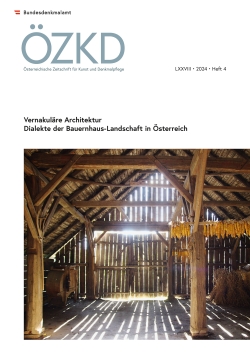
ÖZKD LXXVIII 2024 Heft 4, pp. 9-19, 2025/02/12
Vernakuläre Architektur
Dialekte der Bauernhaus-Landschaft in Österreich

This article starts by critically examining the term “vernacular architecture,” which, unlike in English-speaking countries, has only recently been adapted for use in the German language. It then discusses how monument preservation has treated vernacular architecture since 1900. After an initial romanticizing gaze for the purpose of “sentimental value,” there was no way to actually place specific objects under monument protection until the Monument Preservation Act of 1923. In so doing, farmhouses were to be placed under protection for the first time. During the post-war era, the cultural landscape and vernacular architecture seemed in greater and greater jeopardy. Beginning in the 1970s and 1980s, people started wondering how to deal with the potential “multitude of monuments” and, ultimately, how to select them: deciding which objects should be placed under monument protection.